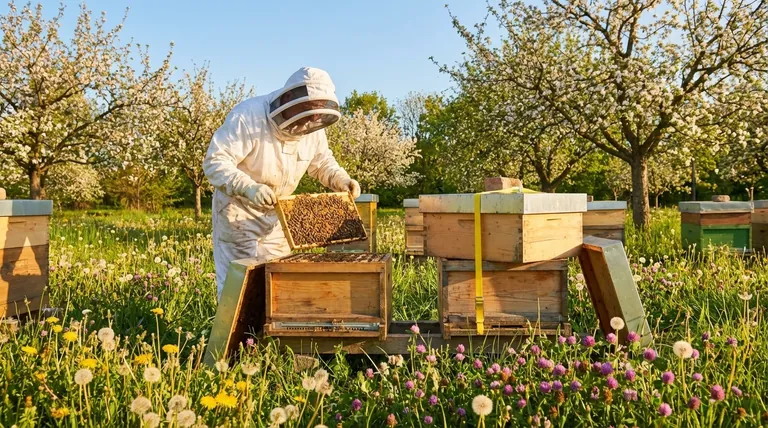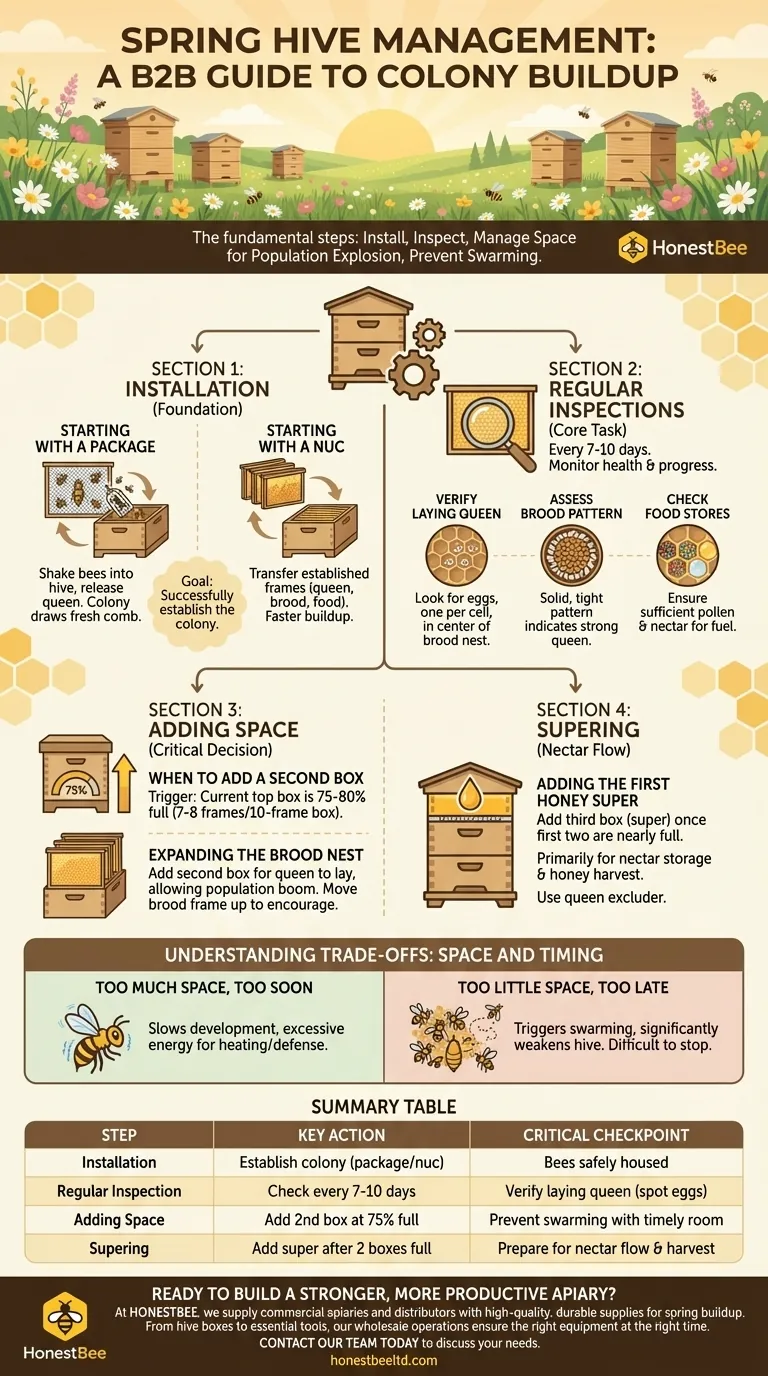The fundamental steps for managing a beehive in Spring are to successfully install your new colony, perform regular inspections to monitor its health and growth, and provide additional space at precisely the right time to support population buildup while preventing the hive from swarming. This process guides the colony's natural explosive growth to ensure it becomes strong enough for the main summer nectar flow.
Your primary objective in the spring is to manage space. You must give the colony just enough room to expand its population and store resources, but not so much that they struggle to warm the hive, and not so little that they feel crowded and decide to swarm.

The Foundation: Installing Your Colony
The first step is establishing the bees in their new home. You will typically start with either a package of bees or a nucleus hive (nuc).
Starting with a Package
A package is a screened box containing several pounds of bees and a caged queen. You install them by shaking the bees into an empty hive box and releasing the queen from her cage among them. The colony must then draw out fresh comb on the frames you provide.
Starting with a Nuc
A nuc is a small, functioning colony with a laying queen, brood, and honey on 4-5 established frames. You install a nuc by simply transferring these frames into your larger hive box and adding new frames to fill the remaining space. Nucs typically build up faster than packages.
The Core Task: Regular Hive Inspections
Once the colony is installed, you must perform inspections every 7-10 days. These brief check-ins are not just about looking at bees; they are about gathering critical data on the hive's health and progress.
Verifying a Laying Queen
The most critical check is for evidence of a healthy, laying queen. You don't need to see the queen herself. Look for tiny, rice-like eggs, one per cell, at the bottom of the cells in the center of the brood nest.
Assessing the Brood Pattern
A strong queen lays in a tight, concentrated pattern. You should see a solid area of capped brood (pupating bees) with a surrounding ring of younger larvae, and eggs on the outside edge. A spotty or scattered brood pattern can indicate a failing queen or disease.
Checking Food Stores
The colony needs fuel to grow. Ensure the bees are bringing in pollen (visible as colorful packed pellets in cells) and nectar (appears as a clear liquid in cells). These are essential for feeding the queen and developing larvae.
The Critical Decision: When to Add a Second Box
The most common mistake for new beekeepers is waiting too long to add more space. A crowded hive is the primary trigger for swarming, where the queen and half the bees leave to find a new home.
The 75% Rule
The standard rule is to add the next hive box when the current top box is about 75-80% full. This means the bees have drawn out comb and are actively using 7 or 8 of the frames in a 10-frame box (or 6 of 8 in an 8-frame box).
Expanding the Brood Nest
The second box you add is for brood nest expansion. The goal is to give the queen ample room to continue laying eggs, allowing the colony's population to boom. You can encourage the bees to move up by placing a frame of brood from the lower box into the center of the new upper box.
Adding the First Honey Super
Once the first two boxes are nearly full of brood, bees, and food, you will add a third box. This box, called a honey super, is intended primarily for nectar storage that will become the honey you harvest. It is often separated from the brood boxes by a queen excluder.
Understanding the Trade-offs: Space and Timing
Managing a spring hive is a balancing act. Your decisions involve clear trade-offs that impact the colony's success.
Too Much Space, Too Soon
Giving a new, small colony a second box too early forces them to expend excessive energy trying to heat and defend a space they cannot occupy. This can slow down brood rearing and overall colony development, especially during a late cold snap.
Too Little Space, Too Late
This is the more dangerous error. If the bees feel crowded and the queen has nowhere to lay, they will activate their swarm instinct. Once they begin preparations to swarm (such as building queen cells), it can be very difficult to stop them. This significantly weakens the hive ahead of the main honey season.
How to Apply This to Your Hive
Your management decisions should be based on the rate of your colony's growth, not a rigid calendar.
- If your hive is growing rapidly in good weather: Be prepared to add the second box within 3-4 weeks of installation and inspect weekly to avoid missing the window.
- If your hive is building slowly due to poor weather or a slow start: Focus inspections on ensuring they have a laying queen and enough food. Do not add the second box until they have clearly met the 75% threshold.
Your role as the beekeeper is to provide the right resources at the right time, guiding the colony's powerful natural instincts toward a productive season.
Summary Table:
| Spring Hive Management Step | Key Action | Critical Checkpoint |
|---|---|---|
| Installation | Establish the colony using a package or nuc. | Ensure bees are safely housed in the hive. |
| Regular Inspection | Check hive every 7-10 days. | Verify a laying queen by spotting eggs. |
| Adding Space | Add a second brood box when 75-80% full. | Prevent swarming by providing timely room. |
| Supering | Add a honey super once two brood boxes are full. | Prepare for the main nectar flow and honey harvest. |
Ready to build a stronger, more productive apiary this season?
At HONESTBEE, we supply commercial apiaries and beekeeping equipment distributors with the high-quality, durable supplies needed to expertly manage every stage of the spring buildup. From hive boxes and frames to essential tools, our wholesale-focused operations ensure you have the right equipment at the right time.
Contact our team today to discuss your wholesale needs and ensure your colonies are set up for a successful and profitable season.
Visual Guide

Related Products
- Professional Galvanized Hive Strap with Secure Locking Buckle for Beekeeping
- Mesh Ventilated 3 Layer Goatskin Beekeepers Gloves for Beekeeping
- Electric Flatting and Embossing Machine with Tray for Beekeeping
- Versatile Ratchet Hive Strap with S-Hooks for Secure Fastening
- Jenter Queen Rearing Kit Complete Set for Bee Breeding
People Also Ask
- Can straps with hook ends be used for beehives? A Guide to Secure Hive Management
- What is the advantage of using cam buckle straps? Secure Your Load Fast with Simple, Safe Tensioning
- What are the two styles of hive straps? Choose the Right Strap for Your Hive Security
- Why are hive straps important for beekeepers? Secure Your Hives Against Wind, Predators & Transport
- What is the best length for straps used around beehives? Why 12 Feet is the Industry Standard



















